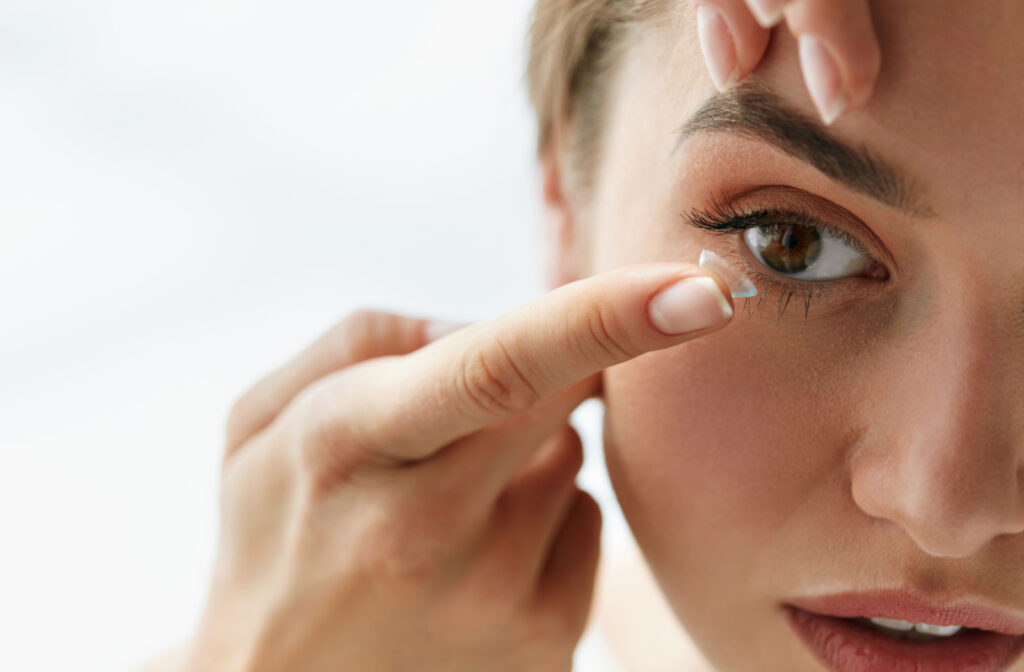If you wear contacts, you’ve probably experienced their exceptional convenience and clear vision. However, you may also notice that they dry out by the end of the day. And if you have chronic dry eyes, your contacts can worsen your dry eye symptoms and contribute to your condition.
Why Do Contact Lenses Dry Out My Eyes?
Contacts offer so many benefits. They allow us to see clearly without the bulkiness of glasses, provide a wider, more natural field of view, and can’t fog up or get splashed with dirt. However, they’re medical devices that sit directly on the surface of your eyes and can affect the health of your eyes.
Contact lenses reduce or prevent oxygen from reaching your eyes, leading to dryness and irritation. Medical experts call this condition “contact lens-associated dry eye disease” (CLD). The condition is most common among people who use soft contact lenses.
Dry eyes can cause uncomfortable and irritating symptoms, including:
- Burning or stinging sensation
- Excessive eye watering
- Redness
- Sensitivity to light
- Blurry vision
- Discomfort wearing contacts
What Causes Dry Eyes?
When we blink, a thin layer of tears called the tear film spreads over our eyes, keeping the surface smooth and clear. The tear film is crucial for maintaining good vision and comfortable, healthy eyes.
The tear film consists of 3 layers, and each one serves a specific purpose:
- The outermost layer is the oily layer, which helps keep the tear surface smooth and prevents the tears from evaporating too quickly. It’s produced by the meibomian glands in our eyelids.
- The middle layer is the watery layer and makes up the majority of our tears. This layer acts as a cleanser, washing away foreign particles that might enter our eyes. It originates from the lacrimal glands in our eyelids.
- The innermost layer is the mucus layer, responsible for spreading the watery layer evenly across the eye’s surface and keeping it moist. Without mucus, tears wouldn’t stick to the eye properly. The conjunctiva, the transparent tissue covering the white part of the eye and the inside of the eyelids, produces this layer.
When something disrupts the function and production of the tear layer, you can develop dry eyes. This disruption can occur due to various factors, including:
- The environment, as dry climates and exposure to windy or dusty conditions
- Certain health conditions, such as arthritis and thyroid disorders.
- Eye conditions, like blepharitis or meibomian gland dysfunction.
- Refractive eye surgeries like LASIK.
- Using a computer for a long time, reading, and other activities that reduce blinking.
Even the use of contact lenses can exacerbate symptoms.
How Do Contact Lenses Contribute to Dry Eyes?
Wearing contact lenses, particularly soft contacts, can contribute to dry eyes in several ways.
One of the main factors is that they can partially block oxygen from entering the eye, which can lead to dryness. The contact lens limits the oxygen flow, resulting in a lack of moisture.
Contact lenses can also disrupt the natural tear film that helps keep the eyes moist, causing the tear film to become imbalanced or disrupted, leading to dryness and discomfort.
Studies have also shown that contact lens use is a risk factor for dry eyes. It has been observed that wearing soft contact lenses, even among young individuals, increases the likelihood of developing dry eyes.
While contact lenses are a convenient alternative to glasses, they require proper care to prevent potential issues like dry eyes. When you wear your lenses, make sure you give your eyes enough breaks throughout the day and clean them thoroughly with the right solutions.
Tips for Preventing Dry Eyes When Wearing Contact Lenses
One easy and effective way to prevent dryness is to practice good hygiene—always wash your hands before touching your lenses and clean and store your lenses in a sanitized lens case and fresh solution.
You can also keep your lenses moist throughout the day using eye drops or lubricants made specifically for contact lenses.
And remember to take breaks from wearing your contacts, especially if you spend a lot of time in front of a computer or staring at your phone. Try not to wear them any longer than 12–16 hours during the day, take them out before you go to bed, and consider wearing your glasses on the weekends if you wear contacts throughout the week.
Types of Contact Lenses Best for Dry Eyes
Talk to your eye doctor if you’re experiencing dry eye discomfort when wearing contact lenses. With constantly evolving contact lens technology, there’s likely a contact lens designed for your eyes! If traditional soft lenses aren’t working for you, there are plenty of options that may work better.
- Daily disposable contacts are thrown out after one day of wear, reducing the risk of dryness.
- Silicone hydrogel contact lenses hold onto moisture better than other types and are particularly beneficial for those who prefer extended wear or have more severe dry eye symptoms.
- Rigid gas permeable (RGP) lenses allow for better oxygen flow to the eyes and don’t dry out easily.
- Scleral lenses are larger than traditional contacts and are designed to rest on the sclera (the white part of the eye) to create a fluid reservoir between the contact and the surface of your eye.
Each person’s experience may vary, so finding the best contacts for your dry eyes may involve some trial and error.

Find Comfort & Clarity with Contact Lenses
Proper care of both your eyes and contact lenses is essential for maintaining good eye health. Regular check-ups and cleaning your lenses according to the guidelines from your optometrist will help prevent eye infections, scratches, and discomfort. We offer comprehensive contact lens exams and fittings at Dr. Chris Schell O.P.C. Call us today to book an appointment!



